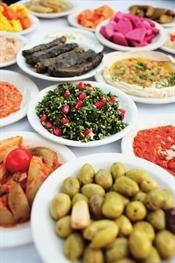
Jewish and Israeli Recipes
A taste of the Promised Land
We hope you enjoy trying out some of these recipes taken from the huge diversity of Israeli and Jewish cuisine.
Some are traditionally Jewish, some are more modern creations from Israel.
Check out the introduction, below, to help get you in the mood for some great culinary ideas from around the Jewish world, and from the heart of the Promised Land itself.
If you have any recipe ideas yourself, please email us to let us know, and we'll post them here too. And don't forget to let us know how you get on through the 'Comments...' area at the bottom of each recipe page.
A small nation, with many tastes
Israel is a small country - just under 280 miles from top to bottom and an average of just 37 miles across. It's demographic, however, is extremely diverse as its cosmopolitan society has been gathered as a literal fulfillment of Biblical prophecy.
"Do not be afraid, for I am with you; I will bring your children from the east and gather you from the west. I will say to the north, 'Give them up!' and to the south, 'Do not hold them back.' Bring
my sons from afar and my daughters from the ends of the earth- everyone who is called by my name, whom I created for my glory, whom I formed and made."
~ Isaiah 43: 5-7
The diversity of contributing nations to the population of Israel is inevitably reflected by the infinite range of cuisine available in the country. The country itself is famous for its fresh fruit
and vegetables (the Jaffa orange has long been a well-known symbol of the country).
Sephardi and Ashkenazi Influences
Israeli, and even Jewish cuisine, can be divided into two main sections - Ashkenazi (from Eastern and Western Europe) and Sephardi (from Middle East countries).
Sephardi food is full of aromatic spices & herbs and tends to be spicier than Ashkenazi cooking. Contemporary Israeli food often combines the two to wonderful effect. It is wonderfully eclectic
and shows the influence of Middle Eastern, Mediterranean, Spanish, German and Eastern European styles of cooking.
So, many of the foods that we think of as Jewish and / or Israeli are not unique to Jewish or Israeli culture.
For example, stuffed cabbage (a traditional Jewish dish) is actually very common in Eastern Europe. Blintzes are familiar to all Germans, not just the Jewish ones. Even dishes such as couscous, falafel and shishlik are popular throughout the country, but all of them originated outside of Israel and now help to flavour, literally, the taste of the Promised Land.




